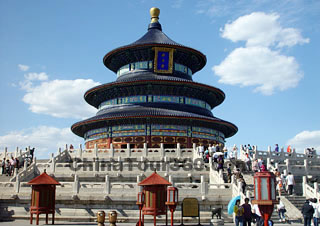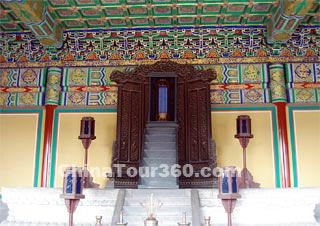Also known as Hall of Prayer for Grain, the Hall of Prayer for Good Harvest was where the the Ming and Qing emperors held ceremonies for good harvests in the first month of spring. It is the core structure of the Temple of Heaven and a landmark from Beijing's days as an ancient capital. Its original shape was rectangular reflecting "Respect to the Heaven and God". It was named "Great Prayer Hall" and was used for offering sacrifices to the heaven and earth. In 1545, Emperor Jiajing of the Ming Dynasty remodeled the Hall into a round structure with tthree tops covered with blue, yellow, green glazed tiles from top to bottom. These colored tiles symbolized heaven, earth and all creation respectively.
|
|
The internal structure of the Hall of Prayer for Good Harvest is unique with interfaced Nanmu (cedar) posts and square rafters meeting one another to support the roof - not one nail was used to build it. This is why it is also called "The Beamless Hall" and is regarded as one of the five wonders among the Temple of Heaven's buildings.
There are 28 Jinsi Nanmu (cedar) pillars in the hall erected according to the astronomical phenomena. The four "Longjing pillars" of the inner circle symbolize the four seasons. The 12 pillars in the middle enclosure symbolize the twelve months of the year. The peripheral 12 symbolize the twelve two-hour periods on a day. Together the 24 pillars in the middle and outer layer symbolize the 24 solar terms in a year. All of the 28 pillars in the hall refer to the 28 constellations in the sky. In addition, there are eight small posts on the top making a total of 36 posts to symbolize the 36 constellations of the Big Dipper.
The most sacred part of the hall is the Altar in the center, and the ancillary altars on its sides. The Altar is 7.87 meters (8.6 yards) in length, 7.52 meters (8.2 yards) in width and 1.07 meters (3.5 feet) in height. All these altars are in the shape of a Xumi Base (the pedestal or base of a Buddhist tower, or temple). The tablet of the God of Heaven is consecrated in the Hall.
The base of the Hall of Prayer for Good Harvest is the Altar of Prayer for Good Harvests standing six meters high (19.7 feet) with three layers. The hall and the base together form an organized architectural structure. The altar base was the best place for the emperors to worshipand prayed for a bountiful harvest. Its stone rails and pillars appear more delicate and luxurious than those of the other buildings. The three-layer steps on the south end of the altar are decorated with a huge relief, known as the Danbi Stone Carving (Imperial Stone Carving). The relief's carvings represent the dragon and phoenix roaming above the clouds, symbolizing the ancient people’s rich imagination and infinite longing to go to Heaven.
![]() East Annex Halls
East Annex Halls
The East Annex Hall displays a large number of essays and pictures of the history and architectural art of the Hall of Prayer for Good Harvest. Included are pictures of the hall, a portrait of Emperor Yongle who ordered the Temple of Heaven to be built, "Ming Hui Canon", a poem written by Emperor Kangxi as well as excerpts of Emperor Qianlong’s poems. In addition, two architectural models of the hall are displayed. One is a complete model of the hall, and the other is a cross-section model. Both models were produced on a scale of 1:15. Components used in the models are the same as the ones used for the actual Hall. They were installed and completed by dozens of craftsmen - a project that took eleven years.
![]() West Annex Hall
West Annex Hall
The West Annex Hall has an exhibition hall, displaying many of the sacrificial items used for worship in ancient times as well as the evolution of worshipping rites. Visitors can gain a clear and intuitive understanding of the historical and mysterious culture of the sacrifice. All the ceremonial vessels used for sacrifices are handled according to strict regulation. The vessels have a hierarchy indicating superiority and inferiority, lowliness nor nobility, old and young and guests and hosts. All of the sacrificial exhibits here have significant artistic value. They show the emperors’ close attention to the meaning of and also reflect the importance of sacrificial rites in ancient China.
![]() Go to the Next Attraction: Architectural Complex of the Altar of Prayer for Good Harvest
Go to the Next Attraction: Architectural Complex of the Altar of Prayer for Good Harvest










